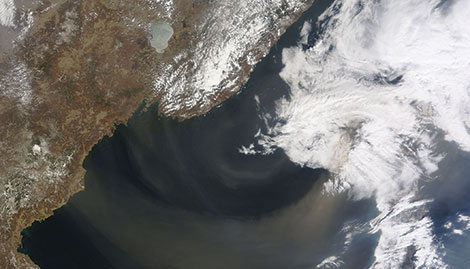UMBC Research links particles & pollution to climate change
Health, climate, and atmospheric issues feat. in UMBC Mag.
Discovery – Winter 2013
PLAYING ITS PARTICLE
Source: UMBC Magazine
Sixty-four million tons of dust and pollution blow across the oceans to North America each year – and our continent itself produces about the same amount on its own. Tracking those particles could prove crucial in assessing changes in the earth’s climate, but scientists have found it difficult to locate and quantify them accurately.
Researchers at NASA’s Goddard Space Flight Center, however, have devised a way to do so using two satellites to draw a three-dimensional picture of airborne particles. In a paper published in Science magazine, the team of researchers asserted that most of what travels to this continent is dust particles, carried as high as six miles up in the atmosphere and blown by winds that disperse them around the world.
Lorraine Remer, a senior research scientist in UMBC’s Joint Center for Earth Systems Technology (JCET), was one of the team of Goddard researchers who devised the system.
“Dust is part of the natural balance,” says Remer, who cites the way that water in clouds condenses around dust particles, affecting the formation and properties of the clouds and thus altering rain patterns, as one example of its importance.
The Goddard researchers examined aerosols – a category of particles that includes both dust (the tiny grains of minerals blown up from deserts and farm lands) and pollution. Scientists know more about the latter (which is produced by industrialization, fires, and transportation) because of its harmful effects on health. Pollution is also more easily measured because it stays closer to the earth’s surface.
Dust, on the other hand, mostly remains high in the atmosphere, and is not a major health issue, says Remer. She and the rest of the team discovered that most of the dust in the skies above North America (between 49 to 77 percent of it) comes from Asia. Africa contributes 15 to 34 percent of that total, with the Middle East adding 7 to 17 percent. Deserts are one major source of dust, and droughts can increase the amount of it.
Remer observes that knowing where dust comes from – and how much there is – can aid our knowledge of climate issues other than rainfall patterns. Dust that falls on mountain ranges can alter how the snow melts and possibly produce “hydrological problems” in regions (including the American West) where that snow melt provides much of the water supply.
Dust also plays a key role in reducing global warming. Because it reflects sunlight, dust particles provide a cooling effect on the climate that mitigates – in a yet undetermined amount – warming trends in the earth’s climate.
Indeed, dust may account for about a third of the Earth’s aerosol reflectivity, which masks some of the effects of warming, says Remer. But she adds that most scientists are dubious about thought experiments that propose adding more dust-like substances (perhaps sulfate particles) to the atmosphere as a sort of “lifeboat maneuver” to further increase reflectivity for a rapidlywarming earth.
“Most people’s reactions are negative, including scientists’,” Remer says. “Scientists don’t like to fuss with the natural world.”
— Joel N. Shurkin
Dust plume over Inner Mongolia beginning its eastward journey over the Sea of Japan. Credit: NASA Earth Observatory/Jeff Schmaltz






